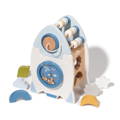Preparing Your 2-Year-Old for Preschool with Montessori Toys
As we all know, 2-year-olds are a bundle full of energy and ready to turn every stone and explore every corner. And, in this stage, it’s crucial to point them in the right direction.
Going through the "terrible twos" phase, both we and our kids are testing new things every day. This is a time when it's clear that they're ready for the next step. Enter the world of the best Montessori toys for 2-year-olds, a perfect field where our kids can explore, learn, and have loads of fun.

Most importantly, Montessori toys are also playing a big role in preparing your child for preschool. Sooner or later, your kid will meet new friends and interact with people, teachers, and other parents; these new encounters are opening the door to a whole new field of learning where Montessori toys can help.
Before we discuss a couple of toys, let’s first take a look at some core principles and the idea behind the Montessori method.
Understanding the Montessori Approach
The Montessori method stands for a special type of learning where children are provided with the right kind of materials to nurture their own pace in education. At the very core of this approach, Dr. Maria Montessori explains the importance of fostering a child's natural curiosity and independence through self-directed learning.

And, for pre-schoolers and two-year-olds, the Montessori method surely offers a lot. Let’s quickly see some pros and cons of Montessori in preschool years.
Pros of Montessori in preschool:
- Individualized learning: Montessori classrooms are designed to each child's pace and style of learning, allowing them to advance through life independently.
- Holistic development: Beyond academics, Montessori education focuses on nurturing a child's emotional, social, and physical development.
- Hands-on learning: Children engage with specially designed materials and Montessori toys that promote exploration, enhancing understanding through sensory experiences.
- Promotes intrinsic motivation: Putting an accent on self-directed learning encourages a child's natural intentions to explore and learn, creating a lifelong love for knowledge.
Cons of Montessori in preschool:
- Teacher qualification: The effectiveness of a Montessori program mostly depends on the teachers' understanding and implementation of the method.
- Transition challenges: As Montessori methods differ significantly from traditional education, transitioning to a conventional school later on may create challenges for some children.
Choosing the Right Montessori Toys for 2-Year-Olds
As your toddler enters the preschool world, exploring every inch of the space around them, providing them with the right kind of toys is crucial.

But how can you choose the right toys?
Let’s unravel this:
Characteristics of Montessori Toys
Simplicity is the primary characteristic of Montessori toys. They are easy to play with, allowing children to focus on specific skills like developing their cognitive side by learning how to put objects in holes.
On top of that, Montessori toys are made from natural materials. It’s always a good option to opt for toys made from wood, fabric, or other natural materials, aligning with the Montessori philosophy of connecting children with the environment.
Age-Appropriate and Skill-Building
Montessori toys are specially designed for your child to allow them to nurture and develop one skill at a time. Take fine motor skills, for example; it’s important to choose toys that encourage the development of fine motor skills, such as stacking blocks, threading beads, or puzzles.

Also, sensory exploration plays a big part in the overall development of 2-year-olds. That’s why Montessori toys are perfect for this kind of practice. Opt for toys that engage multiple senses, focusing on sensory exploration that’s crucial for early childhood development.
Examples of Recommended Montessori Toys
Knowing which toys to pick for your toddler is pretty important. Even if you know exactly which side to nurture in their developmental process, it’s also crucial to learn which toys are best for them.
Let’s break it down with some examples, shall we?

The act of pulling the snail along encourages the development of gross motor skills as your child holds the string and maneuvers the toy around the room. Also, problem-solving is nurtured here as well. As they figure out how to interact with the snail, toddlers engage in problem-solving, promoting cognitive development.
However, perhaps the best thing about this toy is its open-ended nature. Your child can use it the way they want, there’s no manual for it.

Sparking curiosity and cognitive development with this toy is just the tip of the iceberg of possibilities. The interactive features of the learning rocket capture your child's curiosity, focusing on cognitive growth as they explore different shapes, colors, and textures. The hand-eye coordination also comes into play here.
These activities, like placing blocks into specially designed slots, enhance hand-eye coordination, a crucial skill at this age.

The stacking experience of handling building blocks contributes to sensorimotor development, focusing on the connection between sensory input and motor response. That’s where building blocks come into play.
Another great benefit of this toy is the focus on spatial awareness. Namely, constructing and deconstructing with blocks helps develop an awareness of the space, which further helps in understanding shapes and structures.
Transitioning to Preschool: How Our Children Accept the Change?
The transition to preschool might seem like a big step for your child. But we, as parents, can make this big step seem like a seamless walk in the park. The goal is to put trust in your child and talk with them about the transition.
It’s not about forcing them to go away from home and change their environment; it’s about making them love the time they spend in the preschool.
So, let’s divide this into chapters and explain them one by one.
Importance of a Smooth Transition
Before you consider sending your child to preschool, it’s important to see if your child is emotionally ready to accept the change. To make it easy for you, nearly all children have a hard time making this leap. But that’s why we’re here to guide them with the help of Montessori methods.

As we already said, Montessori principles nurture and focus on emotional development. In that light, ensure your child is emotionally ready for the transition. This will help them to create a good picture of the school, the program at school, and their friends in the years to come.
Montessori Principles Aligning with Preschool
Two of the most crucial principles of the Montessori method in preschool are independence and social skills. This is the time when your child will depend on their social skills to interact with others in a group setting.
- Independence and self-directed learning: Montessori's focus on independence aligns perfectly with self-directed learning. This integration encourages children to act on their own, making the transition easier. In other words, if the child is not constantly told what to do, they’ll accept the change faster.

- Social skills: Montessori education puts a strong focus on collaborative play. This skill is valuable as your child starts integrating with others, learning how other children feel and see the world around them.

Incorporating Montessori Principles at Home: Challenges and Solutions
The real science behind the Montessori approach extends beyond classrooms and teachers. By creating an environment at home in which the Montessori methods are applicable, you’ll prepare your child for future challenges.

Here’s a couple of advice to create and educate your child in the Montessori environment:
1. Simplicity in mind: Creating an environment where simplicity and order are present will allow them to learn while they are playing. Simple speaking, organize toys and other learning materials in a way where they are easily accessible to your child. However, keep in mind to establish order by choosing the right place for toys.
2. Propose and focus on independent play: Always provide your child with choices. Make them decide on which toy to play with and how to do it. Don’t make the decision for them; they know what they want, even in the earliest stages of life.
3. Balancing structure with flexibility: Establish a daily routine to provide structure and predictability, but make sure to mix things up from time to time. We all know that routines are essential, but allowing flexibility for spontaneous exploration is also important.
Conclusion:
With Montessori toys for 2-year-olds, you’re not choosing playthings for your child; you’re getting them specially designed materials to foster their development. From the Montessori Pulling Snail inspiring fine motor skills to the Montessori Learning Rocket sparking curiosity, each toy serves a purpose in nurturing a well-rounded foundation.
So, as they transition to preschool and stumble upon new challenges, we’re here to aid them and help them come on top of every obstacle. With the help of the Montessori method and toys, providing your child with the right kind of tools will enable them to go a long way.
Start here, start small, but start with care!
Free Delivery
Over $80
Easy Returns
No questions asked
Unbeatable Warranty
1-year ++ warranty
- Secure CheckoutWorld’s most secure payment method




